Abscisic Acid Inhibits Asymbiotic Germination of Immature Seeds of Paphiopedilum armeniacum
Abstract
1. Introduction
2. Results
2.1. P. armeniacum Seed Is Composed of Only an Undifferentiated Embryo and One Layer of Heavily Lignified Seed Coat
2.2. P. armeniacum Seed Germination Rate Increased During the Early Stages of the Seed Development and Decrease Dramatically after 94 DAP
2.3. Determination of Major Endogenous Hormones Level in Developing Seeds
2.4. Gene Expression Related to Hormone Biosynthesis
2.5. Exogenous ABA Treatment Inhibit Immature Seed Germination
2.6. Reduction in Endogenous ABA Has no Significant Effect on Mature Seed Gemination
3. Discussion
4. Materials and Methods
4.1. Plant Material and Seeds Collection
4.2. Morphological Characterization of Seeds and Embryos
4.3. Seed Asymbiotic Germination Assay
4.4. Measurement of the Endogenous Plant Hormones Levels
4.5. Treatment with Exogenous ABA
4.6. Treatment with Fluridone
4.7. RNA Extraction, De Novo Assembly, Functional Annotation of Unigenes, and Analysis of Differential Genes Expression
4.8. Statistical Analysis
5. Conclusions
Supplementary Materials
Author Contributions
Funding
Acknowledgments
Conflicts of Interest
References
- Liu, Z.J.; Chen, X.Q.; Chen, L.J.; Lei, S.P. The Genus Paphiopedilum in China; Science Press: Beijing, China, 2009. [Google Scholar]
- Cribb, P. The Genus Paphiopedilum; National History Publications: Borneo, Malaysia, 1998; pp. 48–396. [Google Scholar]
- World Checklist of Selected Plant Families. Available online: http://apps.kew.org/wcsp/home.do (accessed on 10 October 2020).
- Cites, Appendices i, ii and iii. Available online: http://www.cites.org/eng/app/appendices.php (accessed on 10 October 2020).
- Chen, T.Y.; Chen, J.T.; Chang, W.C. Plant regeneration through direct shoot bud formation from leaf cultures of Paphiopedilum orchids. Plant Cell Tissue Organ Cult. 2004, 76, 11–15. [Google Scholar] [CrossRef]
- Ding, C.C.; Yu, H.; Liu, F.Y. Factors affecting the germination of Paphiopedilum armeniacum. Acta Bot. Yunnanica 2004, 26, 673–677. [Google Scholar]
- Zeng, S.J.; Wu, K.L.; da Silva, J.A.T.; Zhang, J.X.; Chen, Z.L.; Xia, N.H.; Duan, J. Asymbiotic seed germination, seedling development and reintroduction of Paphiopedilum wardii sumerh., an endangered terrestrial orchid. Sci. Hortic. 2012, 138, 198–209. [Google Scholar] [CrossRef]
- Zeng, S.J.; Wang, J.; Wu, K.L.; da Silva, J.A.T.; Zhang, J.X.; Duan, J. In vitro propagation of Paphiopedilum hangianum perner & gruss. Sci. Hortic. 2013, 151, 147–156. [Google Scholar]
- Nhut, D.T.; Trang, P.T.T.; Vu, N.H.; Thuy, D.T.T.; Van Khiem, D.; Van Binh, N.; Van, K.T.T. A wounding method and liquid culture in Paphiopedilum delenatii propagation. Propag. Ornam. Plants 2005, 5, 158–163. [Google Scholar]
- Long, B.; Niemiera, A.X.; Cheng, Z.Y.; Long, C.L. In vitro propagation of four threatened Paphiopedilum species (orchidaceae). Plant Cell Tissue Organ Cult. 2010, 101, 151–162. [Google Scholar] [CrossRef]
- Arditti, J.; Ghani, A.K.A. Numerical and physical properties of orchid seeds and their biological implications (vol 145, pg 367, 2000). New Phytol. 2000, 146, 569. [Google Scholar]
- Rasmussen, H.N. Terrestrial Orchids: From Seed to Mycotrophic Plant; Cambridge University Press: Cambridge, UK, 1995. [Google Scholar]
- Zeng, S.J.; Huang, W.C.; Wu, K.L.; Zhang, J.X.; da Silva, J.A.T.; Duan, J. In vitro propagation of Paphiopedilum orchids. Crit. Rev. Biotechnol. 2016, 36, 521–534. [Google Scholar]
- Finkelstein, R.; Reeves, W.; Ariizumi, T.; Steber, C. Molecular aspects of seed dormancy. Annu. Rev. Plant Biol. 2008, 59, 387–415. [Google Scholar] [CrossRef]
- Finch-Savage, W.E.; Leubner-Metzger, G. Seed dormancy and the control of germination. New Phytol. 2006, 171, 501–523. [Google Scholar] [CrossRef]
- Ma, Y.L.; Cao, J.; He, J.H.; Chen, Q.Q.; Li, X.F.; Yang, Y. Molecular mechanism for the regulation of aba homeostasis during plant development and stress responses. Int. J. Mol. Sci. 2018, 19, 3643. [Google Scholar] [CrossRef] [PubMed]
- Kinderen, G.V.d. Abscisic acid in terrestrial orchid seeds: A possible impact on their germination. Lindleyana 1987, 2, 84–87. [Google Scholar]
- Lee, Y.I.; Lu, C.F.; Chung, M.C.; Yeung, E.C.; Lee, N. Developmental changes in endogenous abscisic acid concentrations and asymbiotic seed germination of a terrestrial orchid, Calanthe tricarinata lindl. J. Am. Soc. Hortic. Sci. 2007, 132, 246–252. [Google Scholar] [CrossRef]
- Yan, X.N.; Tian, M.; Liu, F.; Wang, C.X.; Zhang, Y. Hormonal and morphological changes during seed development of Cypripedium japonicum. Protoplasma 2017, 254, 2315–2322. [Google Scholar] [CrossRef] [PubMed]
- Lee, Y.I.; Chung, M.C.; Yeung, E.C.; Lee, N. Dynamic distribution and the role of abscisic acid during seed development of a lady’s slipper orchid, Cypripedium formosanum. Ann. Bot. 2015, 116, 403–411. [Google Scholar] [CrossRef] [PubMed]
- Zhang, Y.Y.; Wu, K.L.; Zhang, J.X.; Deng, R.F.; Duan, J.; da Silva, J.A.T.; Huang, W.C.; Zeng, S.J. Embryo development in association with asymbiotic seed germination in vitro of Paphiopedilum armeniacum s. C. Chen et f. Y. Liu. Sci. Rep. 2015, 5, 16356. [Google Scholar] [CrossRef]
- You, J.Y. Studyies on the Seed Development and Asymbiotic Germination of Paphiopedilum; Beijing Forestry University: Beijing, China, 2014. [Google Scholar]
- Zhang, J.J. Embryo Development and Seed Morphology of paphiopedilum, Orchidaceae; Chinese Academy of Sciences: Beijing, China, 2012. [Google Scholar]
- Lee, Y.I.; Yeung, E.C.; Lee, N.; Chung, M.C. Embryo development in the lady’s slipper orchid, Paphiopedilum delenatii, with emphasis on the ultrastructure of the suspensor. Ann. Bot. 2006, 98, 1311–1319. [Google Scholar] [CrossRef]
- Fang, L.; Xu, X.; Li, J.; Zheng, F.; Li, M.Z.; Yan, J.W.; Li, Y.; Zhang, X.H.; Li, L.; Ma, G.H.; et al. Transcriptome analysis provides insights into the non-methylated lignin synthesis in Paphiopedilum armeniacum seed. BMC Genom. 2020, 21, 524. [Google Scholar] [CrossRef]
- Barthlott, W.; Groe-Veldmann, B.; Korotkova, N. Orchid Seed Diversity: A Scanning Electron Microscopy Survey; Turland, N.J., Rodewald, M., Eds.; Botanic Garden and Botanical Museum Berlin-Englera: Berlin, Germany, 2014; Volume 32, pp. 1–245. [Google Scholar]
- Fu, Y.Y.; Jiang, N.; Wu, K.L.; Zhang, J.X.; da Silva, J.A.T.; Duan, J.; Liu, H.T.; Zeng, S.J. Stimulatory effects of sodium hypochlorite and ultrasonic treatments on tetrazolium staining and seed germination in vitro of Paphiopedilum scbg red jewel. Seed Sci. Technol. 2016, 44, 77–90. [Google Scholar]
- Lulsdorf, M.M.; Yuan, H.Y.; Slater, S.M.H.; Vandenberg, A.; Han, X.; Zaharia, L.I.; Abrams, S.R. Endogenous hormone profiles during early seed development of C. Arietinum and C. Anatolicum. Plant Growth Regul. 2013, 71, 191–198. [Google Scholar] [CrossRef]
- Yeung, E.C. A perspective on orchid seed and protocorm development. Bot. Stud. 2017, 58, 33. [Google Scholar] [CrossRef] [PubMed]
- Cardoso, J.C.; Zanello, C.A.; Chen, J.T. An overview of orchid protocorm-like bodies: Mass propagation, biotechnology, molecular aspects, and breeding. Int. J. Mol. Sci. 2020, 21, 985. [Google Scholar] [CrossRef] [PubMed]
- Vishal, B.; Kumar, P.P. Regulation of seed germination and abiotic stresses by gibberellins and abscisic acid. Front. Plant Sci. 2018, 9, 15. [Google Scholar] [CrossRef] [PubMed]
- Chen, J.; Yan, B.; Tang, Y.J.; Xing, Y.M.; Li, Y.; Zhou, D.Y.; Guo, S.X. Symbiotic and asymbiotic germination of Dendrobium officinale(orchidaceae) respond differently to exogenous gibberellins. Int. J. Mol. Sci. 2020, 21, 6104. [Google Scholar] [CrossRef]
- Bosco, R.; Caser, M.; Ghione, G.G.; Mansuino, A.; Giovannini, A.; Scariot, V. Dynamics of abscisic acid and indole-3-acetic acid during the early-middle stage of seed development in Rosa hybrida. Plant Growth Regul. 2015, 75, 265–270. [Google Scholar] [CrossRef]
- Silveira, V.; Balbuena, T.S.; Santa-Catarina, C.; Floh, E.I.S.; Guerra, M.P.; Handro, W. Biochemical changes during seed development in Pinus taeda l. Plant Growth Regul. 2004, 44, 147–156. [Google Scholar] [CrossRef]
- Finkelstein, R.R. Abscisic acid synthesis and response. Arab. Book 2013, 11, e0166. [Google Scholar] [CrossRef]
- Jiang, C.L.; Dai, J.X.; Han, H.L.; Wang, C.; Zhu, L.; Lu, C.Y.; Chen, H.P. Determination of thirteen acidic phytohormones and their analogues in tea (Camellia sinensis) leaves using ultra high performance liquid chromatography tandem mass spectrometry. J. Chromatogr. B Anal. Technol. Biomed. Life Sci. 2020, 1149, 9. [Google Scholar] [CrossRef]
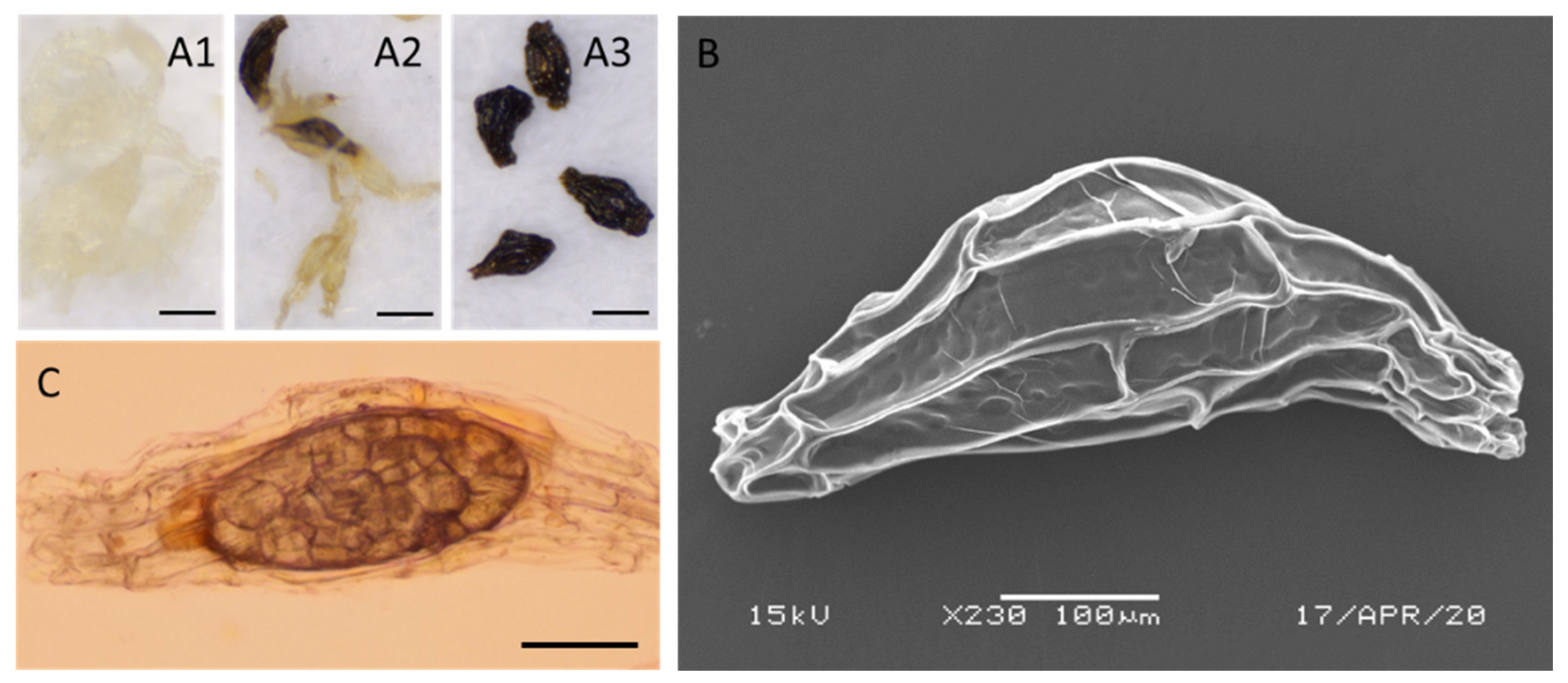
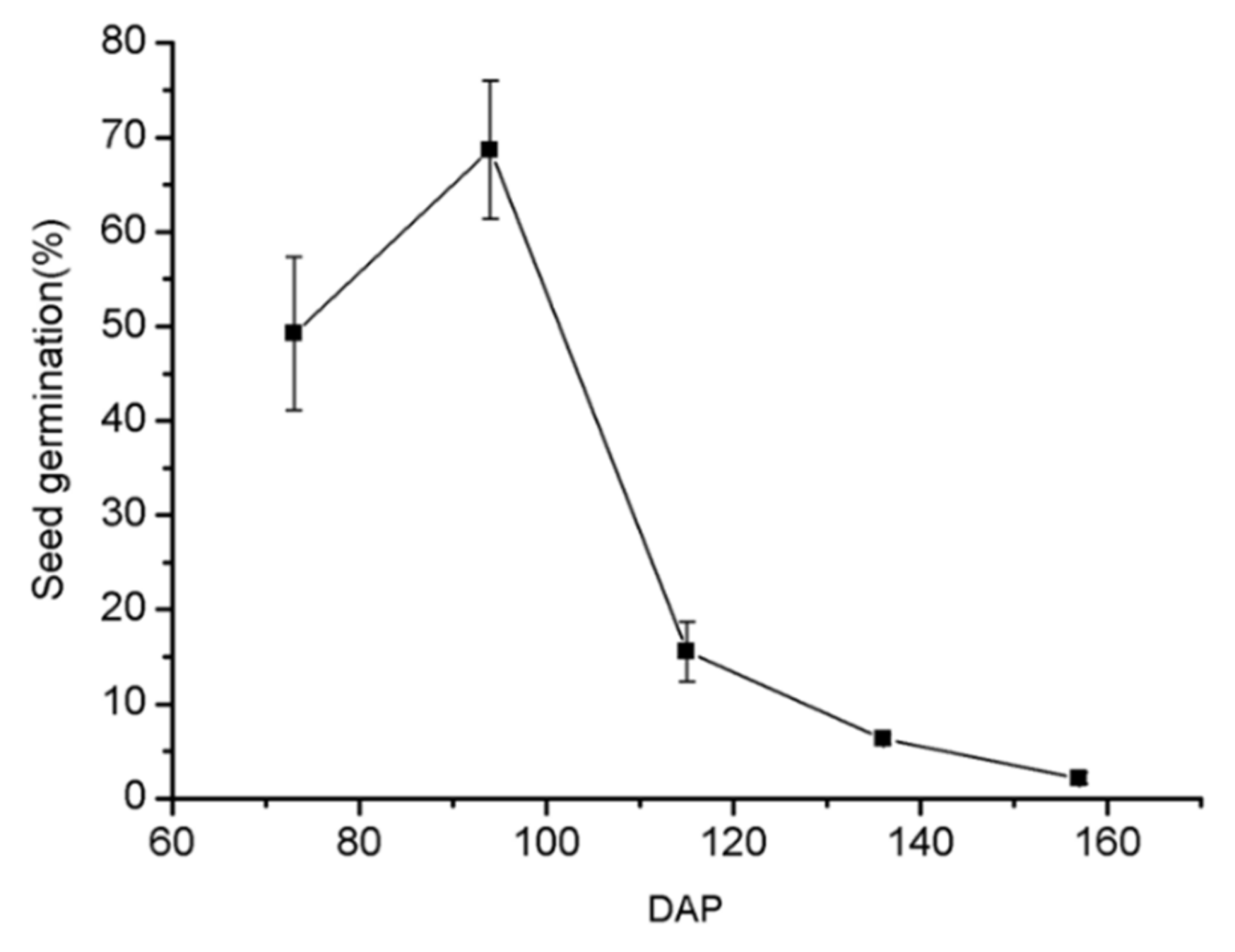

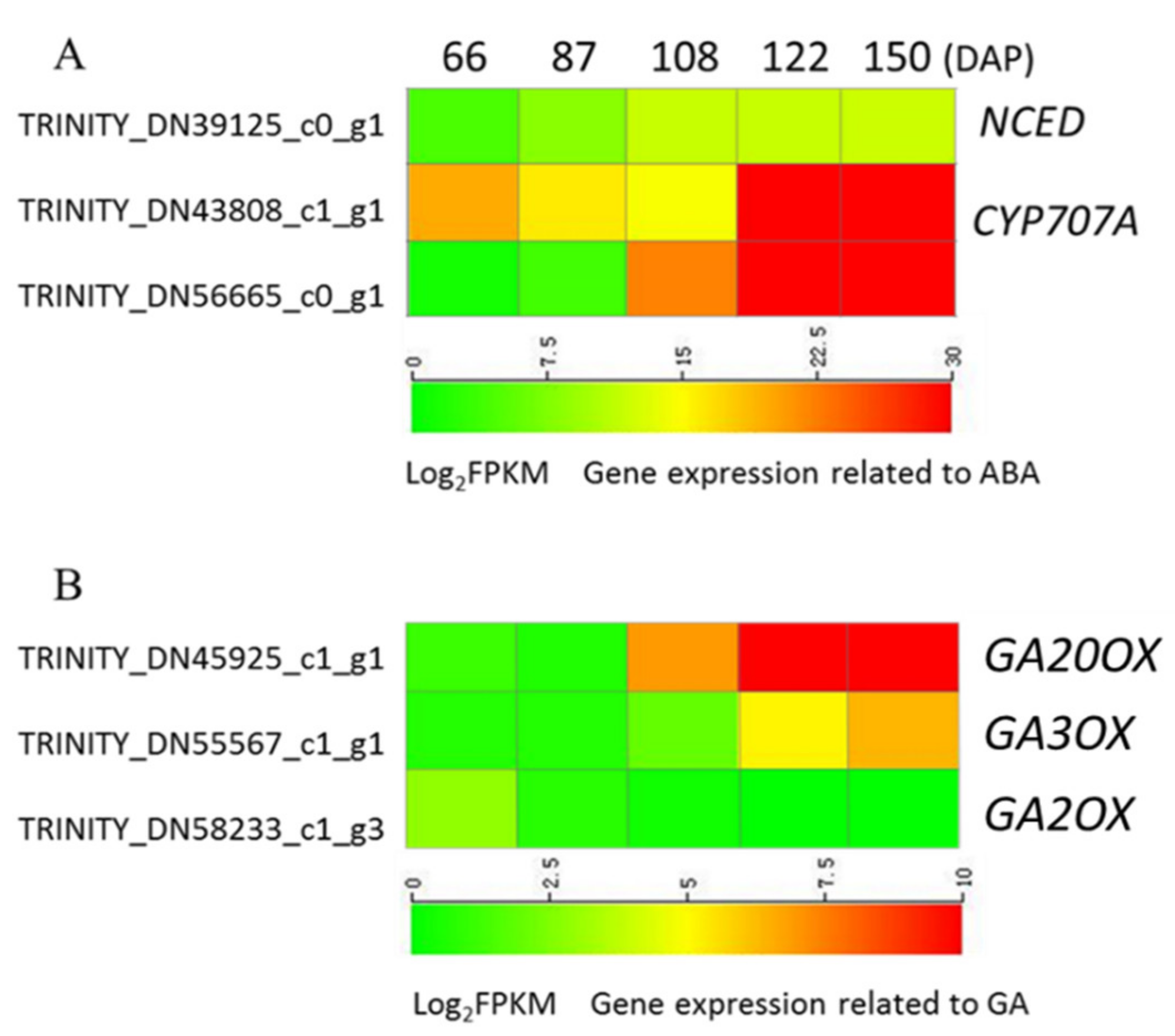

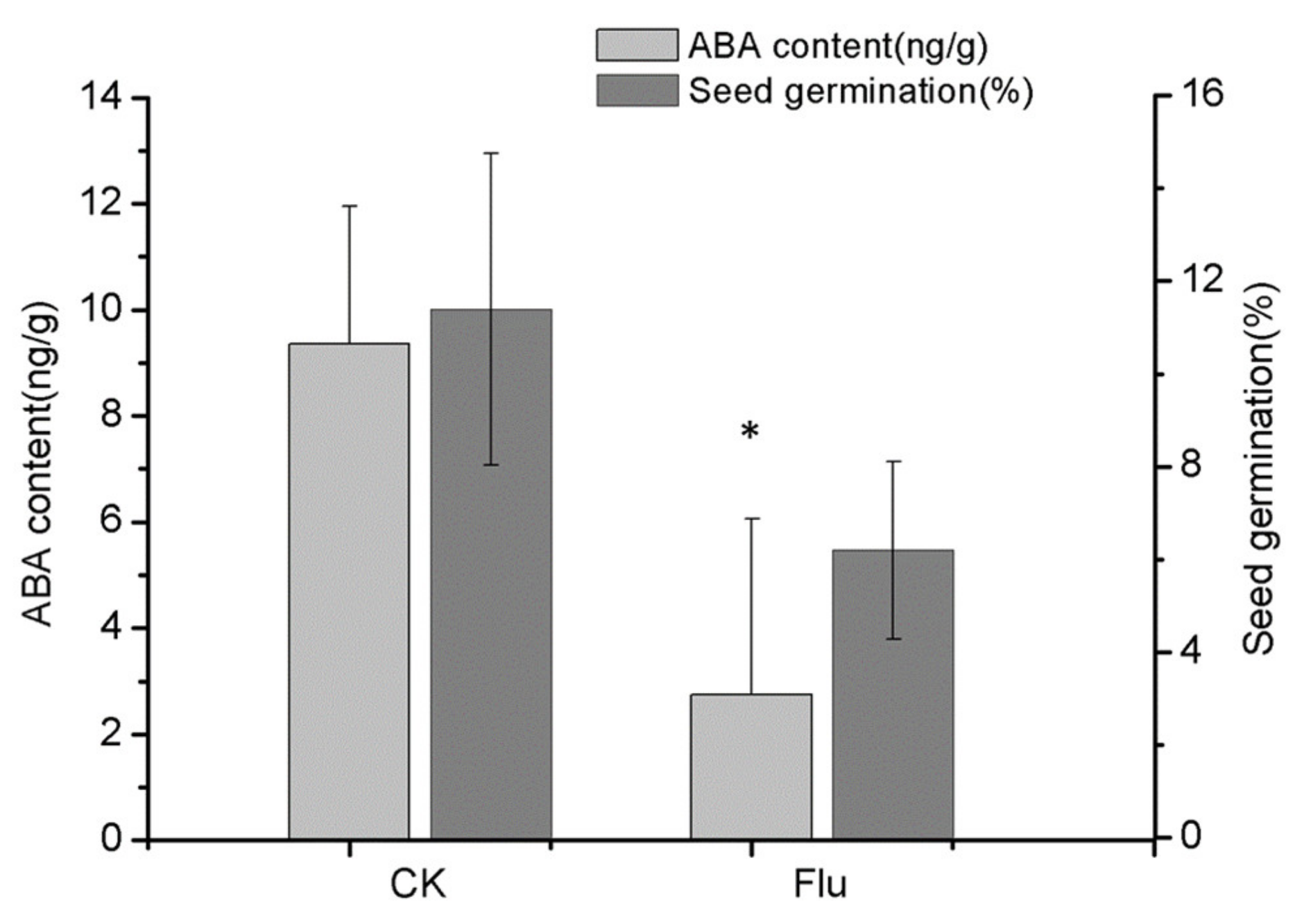
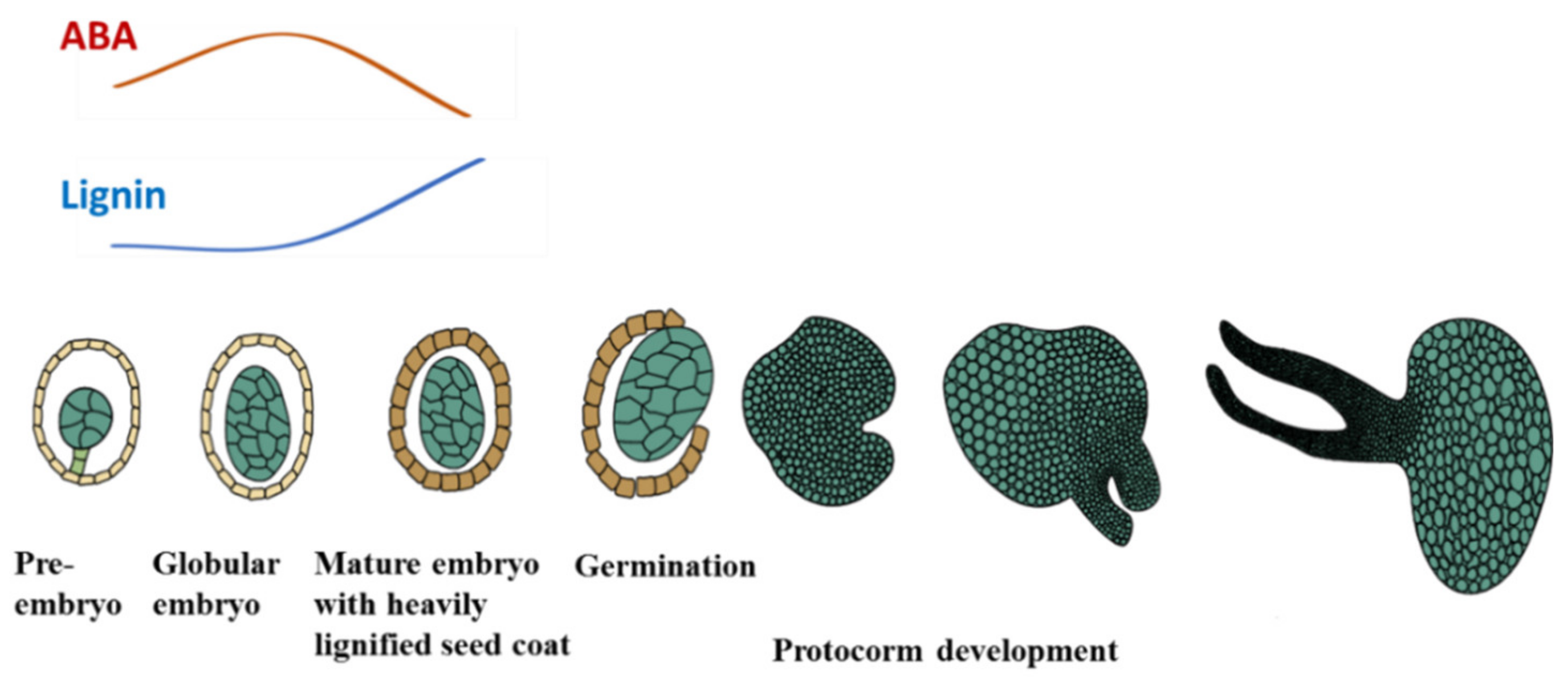
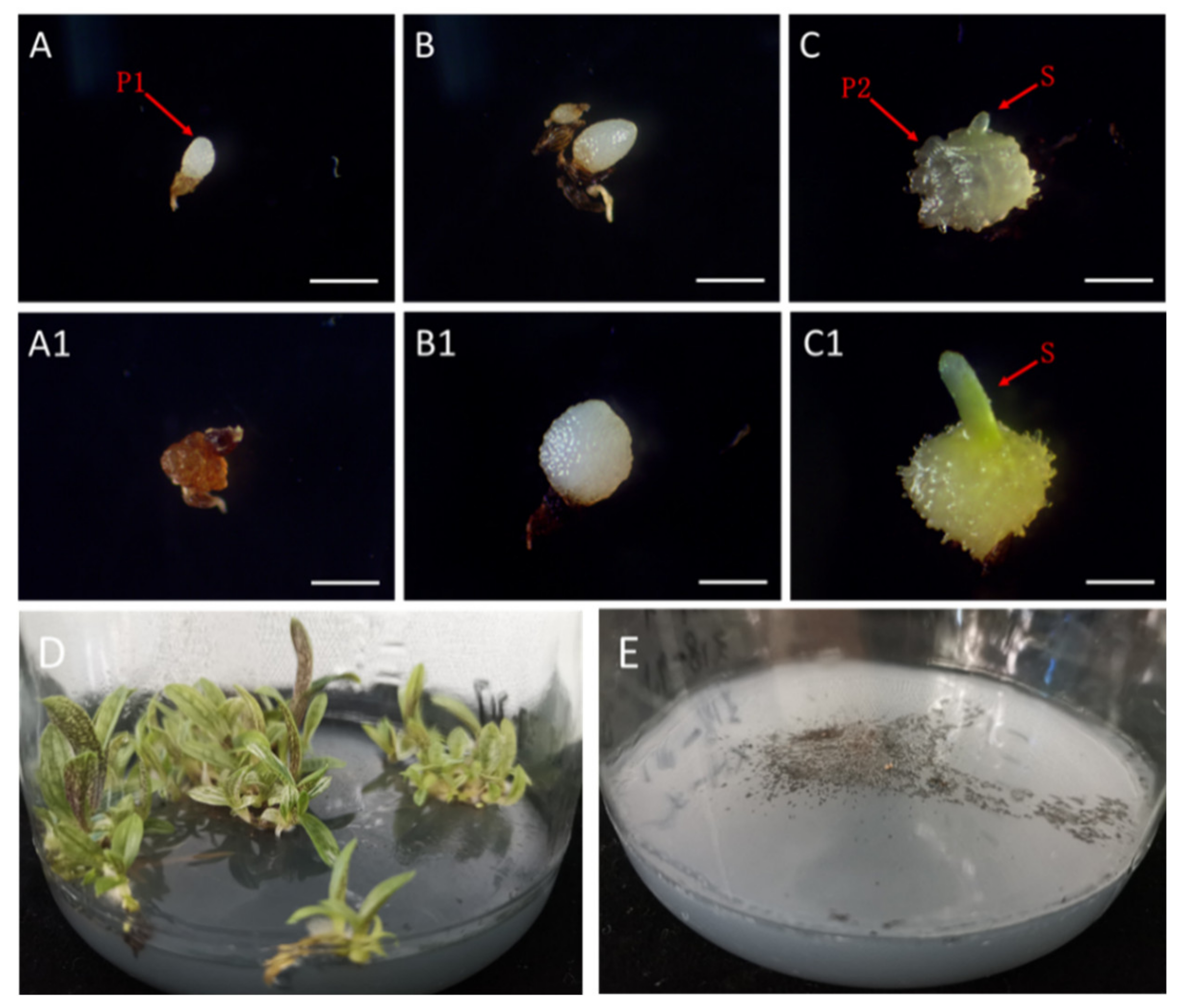
| DAP | Seed Length (μm) | Seed Width (μm) | Seed Length/Width | Seed Color | Embryo Length (μm) | Embryo Width (μm) | Embryo Length/Width |
|---|---|---|---|---|---|---|---|
| 73 | 524.2 ± 22.6 | 135.4 ± 6.1 | 3.9 ± 0.1 | white | 158.1 ± 7.9 | 90.0 ± 3.4 | 1.8 ± 0.1 |
| 94 | 544.2 ± 27.1 | 155.6 ± 6.9 | 3.5 ± 0.2 | white/black | 191.1 ± 12.4 | 115.3 ± 0.5 | 1.7 ± 0.1 |
| 115 | 583.0 ± 22.3 | 177.6 ± 10.0 | 3.3 ± 0.1 | white/black | 207.6 ± 11.8 | 114.4 ± 2.6 | 1.8 ± 0.1 |
| 129 | 519.5±15.1 | 155.7 ± 1.9 | 3.3 ± 0.1 | black | 199.5 ± 5.2 | 111.1 ± 0.9 | 1.8 ± 0.0 |
| 150 | 488.9 ± 6.5 | 172.3 ± 2.9 | 2.8 ± 0.0 | black | 216.4 ± 10.9 | 116.0 ± 3.3 | 1.9 ± 0.1 |
Publisher’s Note: MDPI stays neutral with regard to jurisdictional claims in published maps and institutional affiliations. |
© 2020 by the authors. Licensee MDPI, Basel, Switzerland. This article is an open access article distributed under the terms and conditions of the Creative Commons Attribution (CC BY) license (http://creativecommons.org/licenses/by/4.0/).
Share and Cite
Xu, X.; Fang, L.; Li, L.; Ma, G.; Wu, K.; Zeng, S. Abscisic Acid Inhibits Asymbiotic Germination of Immature Seeds of Paphiopedilum armeniacum. Int. J. Mol. Sci. 2020, 21, 9561. https://doi.org/10.3390/ijms21249561
Xu X, Fang L, Li L, Ma G, Wu K, Zeng S. Abscisic Acid Inhibits Asymbiotic Germination of Immature Seeds of Paphiopedilum armeniacum. International Journal of Molecular Sciences. 2020; 21(24):9561. https://doi.org/10.3390/ijms21249561
Chicago/Turabian StyleXu, Xin, Lin Fang, Lin Li, Guohua Ma, Kunlin Wu, and Songjun Zeng. 2020. "Abscisic Acid Inhibits Asymbiotic Germination of Immature Seeds of Paphiopedilum armeniacum" International Journal of Molecular Sciences 21, no. 24: 9561. https://doi.org/10.3390/ijms21249561
APA StyleXu, X., Fang, L., Li, L., Ma, G., Wu, K., & Zeng, S. (2020). Abscisic Acid Inhibits Asymbiotic Germination of Immature Seeds of Paphiopedilum armeniacum. International Journal of Molecular Sciences, 21(24), 9561. https://doi.org/10.3390/ijms21249561





